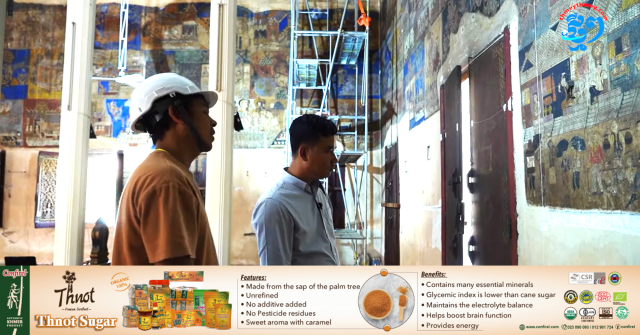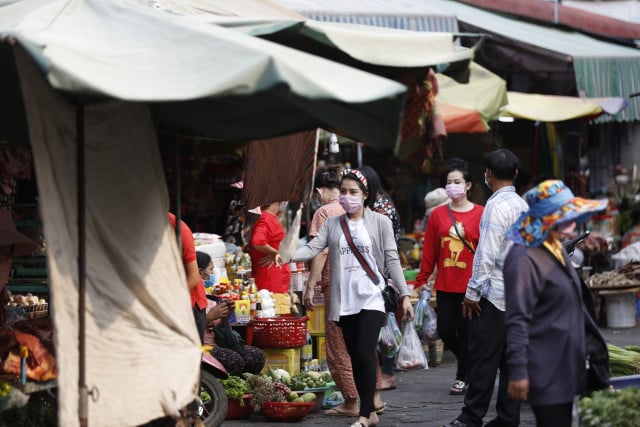Reach Bo Pagoda’s Vihara and Murals Being Restored

- By Sem Vanna
- February 4, 2024 1:00 PM
SIEM REAP — Located in Siem Reap city, Wat Reach Bo, or Reach Bo pagoda, which was likely built in the 18th century, has long been testimony to the country’s devotion to Buddhism.
_1707024145.png)
In the hall of the pagoda’s main chapel, murals mainly illustrate the Reamker—as the Hindu epic tale Ramayana is called in Khmer. While experts disagree as to exactly when they were painted, they all believe that the scenes were done more than a century ago, either in the late 19th or early 20th century.
_1707024292.png)
The murals are currently being restored and, as explained Ro Sovandaroth, a conservation officer of the APSARA National Authority, this is proving a challenging task.
_1707024369.png)
Caption: Ro Sovandaroth, a conservation officer of the APSARA National Authority, during an interview with ThmeyThmey News at the vihara of Reach Bo pagoda. Photo: ThmeyThmey News
Sem Vanna: Looking at the style of the vihara (main chapel hall), this vihara and the murals are quite old.
Ro Sovandaroth: Based on the words of the pagoda’s high monk and the written records, this vihara (main chapel hall) was built during the 17th century. The structure was made of wood and there was only the statue of the Buddha inside. During the early 18th century, the vihara was rebuilt with brick and mortar.
The murals tell the story of the Reamker, the Cambodian version of the Ramayana. The entire painting is divided into scenes with short texts written on them. They are set on three levels with 157 individual scenes. Very little records were made about the date of the paintings, making it hard to pinpoint the timeline with precision.
_1707024566.png)
Sem Vanna: Judging by the colours, I assumed they were done according to traditional techniques?
Ro Sovandaroth: These colours used in the paintings were mostly made through natural processes such as certain types of leaves and some animal parts. The main colours used here are blue, yellow, red, black and white.
Before the restoration of the vihara’s roof, rainwater slightly damaged the paintings as did smoke from candles and incense sticks used here…this being a place of worship.
_1707024664.png)
Through financial support from the Indian government for the restoration project, there are two important works that we need to do. First, we need to restore the vihara’s wall [as layers of the wall are coming off]. It will involve technical procedures and equipment to map out and analyse the condition of the wall.
_1707024719.png)
After that, cleaning operations, both dry cleaning and wet cleaning, will be conducted. If you look at each spot attentively, you will see small areas of contamination such as insect nests and layers of cement added over the years. These things need to be addressed. Wet cleaning is also a tricky operation since it involves chemical agents. We must make sure that the murals remain in good condition and only the contaminants are removed.
_1707024768.png)
In between cracks, we have to apply mortar to strengthen the structure. However, for the mural, we can only do some retouching. We cannot just paint something entirely new. Currently, we are recording and reporting information about this part of the restoration so that it’s easier for us to coordinate and import some necessary equipment from overseas if need be.
_1707024830.png)
Sem Vanna: How tricky is it restore old structures?
Ro Sovandaroth: Old structures require a certain level of old construction techniques. Here for example, if we apply modern cement on the old mortar, the extent of material expansion between the old and the new is uneven. Of course, today’s cement will be a lot stronger, but its strength will cause damage to the original mortar. That is where we have to be very careful. This eastern wall of the vihara is expected to be restored this year. Currently, we have a team of 15 workers on the project.
_1707024886.png)
_1707024921.png)
_1707025005.png)
Conducted in Khmer for ThmeyThmey News, the interview was translated by Ky Chamna for Cambodianess News.
To watch the original interview in Khmer language, click here.
To read and watch more on Khmer Buddhist pagodas:
Meet the 12 Pagodas Along the Siem Reap Stream
Opinion: The Role of Buddhist Pagodas in the Building of Cambodia’s Society
Pagoda Terraces Shed Light on Post-Angkorian Time















